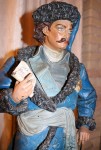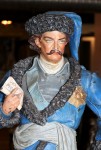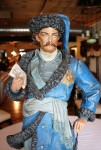414-254-8885 | Email Us
Walter Holtz / 9th Street
ANTIQUES
Antiques & Vintage Collectibles
Spelter Peter The Great in original painted condition 167
Peter the Great was a Russian czar (King) in the late 17th century, who is best known for his extensive reforms in an attempt to establish Russia as a great nation.
Overview
Born in Moscow, Russia on June 9, 1672, Peter the Great was a Russian czar in the late 17th century who is best known for his extensive reforms in an attempt to establish Russia as a great nation. He created a strong navy, reorganized his army according to Western standards, secularized schools, administered greater control over the reactionary Orthodox Church, and introduced new administrative and territorial divisions of the country.
Early Rule
Peter the Great was born Pyotr Alekseyevich on June 9, 1672 in Moscow, Russia. Peter the Great was the 14th child of Czar Alexis by his second wife, Natalya Kirillovna Naryshkina. Having ruled jointly with his brother Ivan V from 1682, when Ivan died in 1696, Peter was officially declared Sovereign of all Russia. Peter inherited a nation that was severely underdeveloped compared to the culturally prosperous European countries. While the Renaissance and the Reformation swept through Europe, Russia rejected westernization and remained isolated from modernization.
During his reign, Peter undertook extensive reforms in an attempt to reestablish Russia as a great nation. Peter overcame opposition from the country's medieval aristocracy and initiated a series of changes that affected all areas of Russian life. He created a strong navy, reorganized his army according to Western standards, secularized schools, administered greater control over the reactionary Orthodox Church, and introduced new administrative and territorial divisions of the country.
Sweeping Changes
Peter focused on the development of science and recruited several experts to educate his people about technological advancements. He concentrated on developing commerce and industry and created a gentrified bourgeoisie population. Mirroring Western culture, he modernized the Russian alphabet, introduced the Julian calendar, and established the first Russian newspaper.
Peter was a far-sighted and skillful diplomat who abolished Russia's archaic form of government and appointed a viable Senate, which regulated all branches of administration, as well as making, groundbreaking accomplishments in Russia's foreign policy.
Territorial Gains
Peter acquired territory in Estonia, Latvia and Finland; and through several wars with Turkey in the south, he secured access to the Black Sea. In 1709, he defeated the Swedish army by purposely directing their troops to the city of Poltva, in the midst of an unbearable Russian winter. In 1712, Peter established the city of St. Petersburg on the Neva River and moved the capital there from its former location in Moscow. Shortly after, St. Petersburg was deemed Russia's "window to Europe."
Shortcomings and Death
Under Peter's rule, Russia became a great European nation. In 1721, he proclaimed Russia an empire and was accorded the title of Emperor of All Russia, Great Father of the Fatherland, and "the Great." Although he proved to be an effective leader, Peter was also known to be cruel and tyrannical. The high taxes that often accompanied his various reforms led to revolts among citizens, which were immediately suppressed by the imposing ruler. Peter, a daunting 6 1/2 feet tall, was a handsome man who drank excessively and harbored violent tendencies.
Peter married twice and had 11 children, many of whom died in infancy. The eldest son from his first marriage, Alexis, was convicted of high treason by his father and secretly executed in 1718. Peter the Great died on February 8, 1725, without nominating an heir. He is entombed in the Cathedral of Saints Peter and Paul, located in in St. Petersburg.












